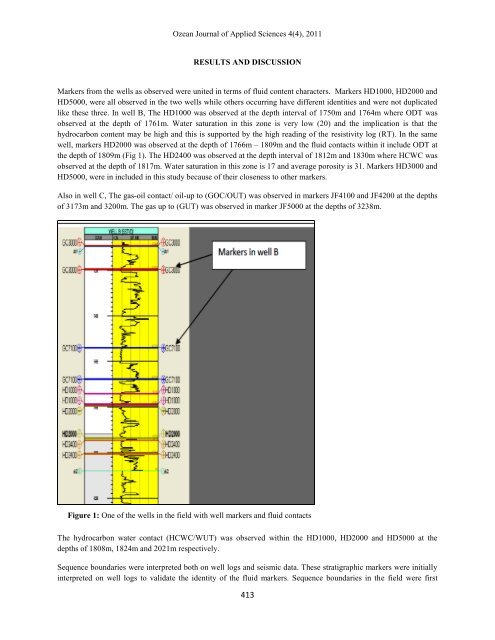download current issue - Ozean Publications
download current issue - Ozean Publications
download current issue - Ozean Publications
You also want an ePaper? Increase the reach of your titles
YUMPU automatically turns print PDFs into web optimized ePapers that Google loves.
<strong>Ozean</strong> Journal of Applied Sciences 4(4), 2011<br />
RESULTS AND DISCUSSION<br />
Markers from the wells as observed were united in terms of fluid content characters. Markers HD1000, HD2000 and<br />
HD5000, were all observed in the two wells while others occurring have different identities and were not duplicated<br />
like these three. In well B, The HD1000 was observed at the depth interval of 1750m and 1764m where ODT was<br />
observed at the depth of 1761m. Water saturation in this zone is very low (20) and the implication is that the<br />
hydrocarbon content may be high and this is supported by the high reading of the resistivity log (RT). In the same<br />
well, markers HD2000 was observed at the depth of 1766m – 1809m and the fluid contacts within it include ODT at<br />
the depth of 1809m (Fig 1). The HD2400 was observed at the depth interval of 1812m and 1830m where HCWC was<br />
observed at the depth of 1817m. Water saturation in this zone is 17 and average porosity is 31. Markers HD3000 and<br />
HD5000, were in included in this study because of their closeness to other markers.<br />
Also in well C, The gas-oil contact/ oil-up to (GOC/OUT) was observed in markers JF4100 and JF4200 at the depths<br />
of 3173m and 3200m. The gas up to (GUT) was observed in marker JF5000 at the depths of 3238m.<br />
Figure 1: One of the wells in the field with well markers and fluid contacts<br />
The hydrocarbon water contact (HCWC/WUT) was observed within the HD1000, HD2000 and HD5000 at the<br />
depths of 1808m, 1824m and 2021m respectively.<br />
Sequence boundaries were interpreted both on well logs and seismic data. These stratigraphic markers were initially<br />
interpreted on well logs to validate the identity of the fluid markers. Sequence boundaries in the field were first<br />
413

















